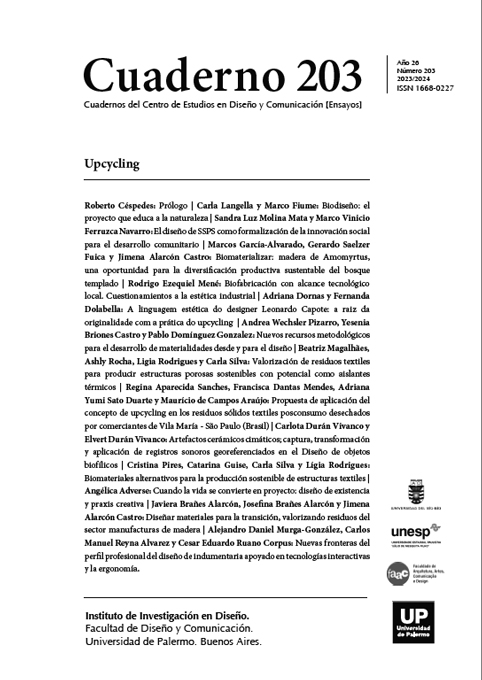Nuevas fronteras del perfil profesional del diseño de indumentaria apoyado en tecnologías interactivas y la ergonomía
Résumé
Con el avance tecnológico es posible abordar desde el pensamiento de diseño aspectos que no eran pensables dentro del perfil profesional
Références
Bagnara, S. (2020). Foreword. In Ergonomics and Design. In Tosi, F. Ergonomics and Design (pp. v-ix). Springer. Cham.
Celentano, A., & Dubois, E. (2015). Evaluating metaphor reification in tangible interfaces. Journal on Multimodal User Interfaces, 9, 231-252.
Duharte-Solis, M. A. (2016). “La asimilación de la tecnología vestible: análisis de las relaciones entre cuerpo, vestimenta y electrónica”. (Tesis de Maestría). Universidad Nacional Autónoma de México, México. Recuperado de https://repositorio.unam.mx/contenidos/82538
Evans, S.K., Pearce, K.E., Vitak, J., & Treem, J.W. (2017). Explicating affordances: A conceptual framework for understanding affordances in communication research. Journal of Computer-Mediated Communication, 22(1), 35–52.
Flores, C. (2001). Ergonomía para el diseño. Teoría y práctica: Designio.
Frayling, C. (1993). Research into Art & Design. London: Royal College of Art.
Gibson, J. J. (1977). The theory of affordances. Hilldale, USA, 1(2), 67-82.
Green, W. S., & Jordan, P. W. (2002). Pleasure with products: Beyond usability. CRC press.
Hollnagel, E. (1997). Cognitive ergonomics: it’s all in the mind. Ergonomics, 40(10), 1170- 1182.
IEA (2000). The International Ergonomics Association: What Is Ergonomics (HFE)? https://iea.cc/about/what-is-ergonomics/
Jordan, P. W. (1998). An introduction to usability. Crc Press.
Kieras, D. E., & Meyer, D. E. (1997). An overview of the EPIC architecture for cognition and performance with application to human-computer interaction. Human–Computer Interaction, 12(4), 391-438.
Löbach, B., & Schmidt, H. (1976). Was ist Industrial Design?. Internationales Design- Zentrum.
Marcus, A. (2002). Dare we define user-interface design?. interactions, 9(5), 19-24.
Nielsen, J. (1994b). Usability engineering. Elsevier.
Nielsen, J. (1994c). Enhancing the explanatory power of usability heuristics. In Conference on Human Factors in Computing Systems (pp. 152–158). Boston, Massachusetts.
Nielsen, J. (1995). 10 usability heuristics for user interface design. Nielsen Norman Group.
Nielsen, J., & Mack, R. L (eds.). (1994a). Usability inspection methods. New York, NY: John Wiley & Sons. ISBN: 0-471-01877-5
Nielsen, J., & Molich, R. (1990). Heuristic evaluation of user interfaces. In Conference on Human Factors in Computing Systems (pp. 249–256). Seattle, Washington.
Norman DA (1999) Affordances, conventions and design. Interaction 6(3):38–43. ACM Press. doi:10.1145/301153.301168
Norman DA (2004) Emotional design. Basic Books, Cambridge
Norman DA (2010) Living with complexity. MIT Press, Cambridge
Norman, D. A. (1983a). Design rules based on analyses of human error. Communications of the ACM, 26(4), 254–258. https://doi.org/10.1145/2163.358092
Norman, D. A. (1983b). Design principles for human-computer interfaces. In Proceedings of the SIGCHI Conference on Human Factors in Computing Systems (CHI ’83) (pp. 1–10). New York, NY: Association for Computing Machinery. https://doi.org/10.1145/800045.801571
Norman, D. A. (1988). The design of everyday things. New York: Basic Books.
Osiurak, F., Rossetti, Y., & Badets, A. (2017). What is an affordance? 40 years later. Neuroscience & Biobehavioral Reviews, 77, 403-417.
Painter-Morland, M. (2011). Rethinking responsible agency in corporations: Perspectives from Deleuze and Guattari. Journal of Business Ethics, 101(1), 83-95.
Tosi, F. (2020). Ergonomics and Design. In Design for Ergonomics (pp. 3-29). Springer, Cham.
Los autores/as que publiquen en esta revista ceden los derechos de autor y de publicación a "Cuadernos del Centro de Estudios de Diseño y Comunicación", Aceptando el registro de su trabajo bajo una licencia de atribución de Creative Commons, que permite a terceros utilizar lo publicado siempre que de el crédito pertinente a los autores y a esta revista.


